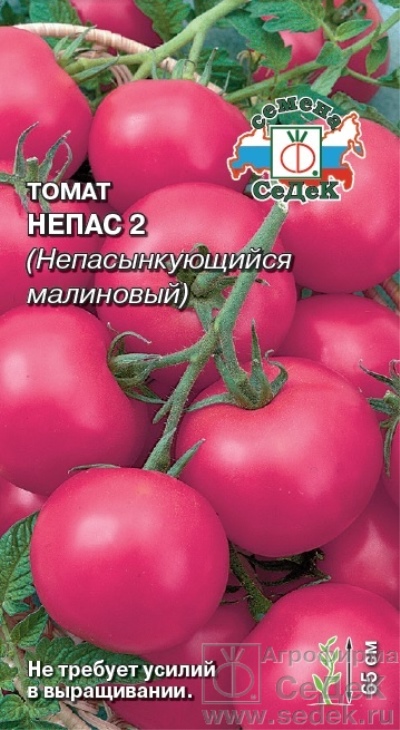
- Authors: Lukyanenko A.N., Dubinin S.V., Dubinina I.N.
- Year of approval: 2017
- Category: hybrid
- Growth type: determinant
- Appointment: fresh consumption
- Ripening period: mid-season
- Ripening time, days: 95-110
- Growing conditions: for open ground, for film greenhouses
- Bush height, cm: 65
- Leaves: medium, dark green
Every gardener is faced with such a laborious procedure as pinching tomatoes. If you neglect it, then the main shoots will not have enough nutrients to give many inflorescences, and get a bountiful harvest. Domestic breeders carried out painstaking work and created the Nepas 2 tomato, which does not require additional work to remove stepchildren.
Description of the variety
The authorship of the appearance of Nepas 2 belongs to the domestic breeders of the Sedek agricultural firm A. N. Lukyanenko. S. V. Dubinin, I. A. Dubinina. Was approved for use in 2017.
Plant of determinant type. The compact bush reaches a height of no more than 65 cm. The leaves are medium in size, dark green in color.
The variety has significant advantages:
high rates of adaptability to extreme climatic conditions;
high-yielding;
tomatoes tolerate transportation well, do not crack, retaining their presentation;
persistent immunity to most infectious diseases.
But, unfortunately, the tomato is not without its drawbacks:
for good growth, it is necessary to make regular feeding;
despite the fact that the bushes are strong, it is better to tie them to a support.
The main qualities of the fruit
Rounded, slightly ribbed fruits are first colored in light green tones, acquiring a bright crimson color during technical maturity, small in size 100-140 g. They have a dense glossy skin.
Taste characteristics
The taste harmoniously combines sweetness and light sourness. The fleshy watermelon pulp has few seeds and nests, as well as a balanced content of organic acids, vitamins and sugars.
Ripening and fruiting
Medium early grade. Fruits begin to ripen 95-110 days after seed germination. The harvest begins in July-August, but the fruiting period depends on the growing conditions.
Yield
It is characterized by high productivity. From one square. m collect 8.2 kg of fruit.
The timing of planting seedlings and planting in the ground
Sowing seeds for seedlings is carried out in March - early April. They begin to plant seedlings in a permanent place no earlier than mid-May in the middle lane and southern regions. In mid-June, planting in open ground begins in regions with a cold climate.

Growing tomato seedlings is an extremely important process, because it largely depends on whether the gardener will be able to harvest at all. All aspects must be taken into account, from seedbed preparation to planting in the ground.
Landing scheme
It is best to stick to a distance of 40 x 40 cm. On one square. m you can plant 4-6 bushes.

Growing and care
The main feature of the Nepas 2 variety is that in the process of growth, the tomato forms a small number of shoots that grow on the sides, without taking food from the main trunk. The bush does not need to be pinned, so there is no need for the formation of the stem. But, so that it does not break under the load of a large number of fruits, a garter to the support is required.
The plant can be planted both in the greenhouse and in the open field. Given the right climatic conditions, these tomatoes can be grown almost anywhere. The soil should be fertile enough, light loam. Prefers to grow in full sun.
They begin to land on a permanent place when the ground warms up to a temperature of + 18 ... 20 degrees, and the threat of recurrent cold weather has passed. The ideal time for this event is cool, cloudy weather or evening, which allows plants to adapt to new conditions more quickly and easily.
Seedlings grown in separate pots practically do not feel transplanted. And also if measures for hardening were previously taken, adaptation is much faster. The soil should be loose, breathable, before planting it is enriched with organic matter, mineral complex fertilizers.
The holes are made shallow, the depth of the bayonet of the shovel, with the simultaneous installation of stakes for support. After planting, the soil is tamped, spilled well with warm water. Further watering should be done carefully. It is very important that water does not get on the leaves, which can lead to the development of pathogenic microorganisms. It is best to use drip irrigation.
Root mulching helps to avoid the tedious process of loosening and retains moisture for longer. The first top dressing is applied no earlier than a month later, provided that all agrotechnical requirements were taken into account when preparing the soil. For the plant to grow green mass, nitrogen is needed. The next top dressing is carried out after the formation of ovaries, applying phosphorus-potassium fertilizers.




A plant needs different micronutrients at each stage of growth. All fertilizers can be divided into two groups: mineral and organic. Folk remedies are often used: iodine, yeast, bird droppings, eggshells.
It is important to observe the rate and period of feeding. This also applies to folk remedies and organic fertilizers.
Disease and pest resistance
Another value of the culture is strong immunity, resistant to diseases such as fusarium wilting, tobacco mosaic virus, and apical rot. In addition, tomatoes do not crack at sudden temperature changes or high humidity in the soil.


Growing regions
The variety was adapted from the very beginning to the southern regions, it is there that it shows the highest yields. Thanks to its selection achievements, it can be grown practically throughout the entire territory of Russia.

























































































